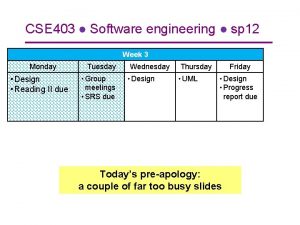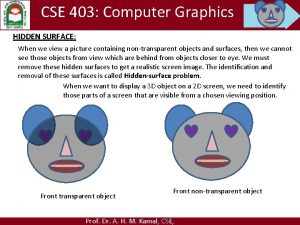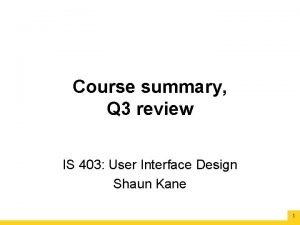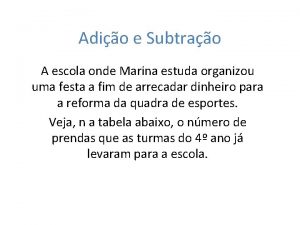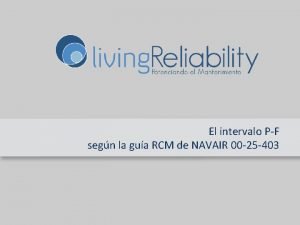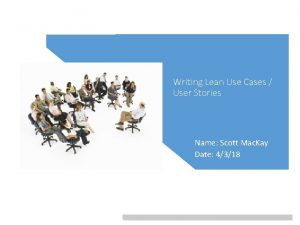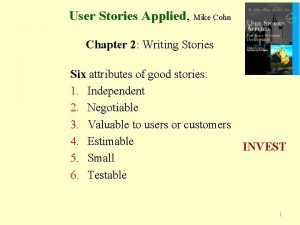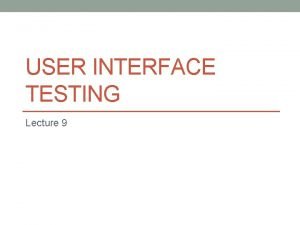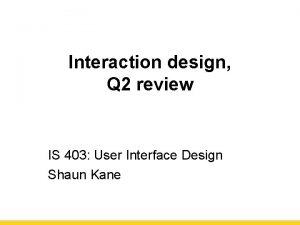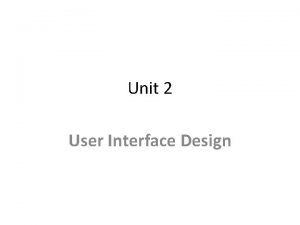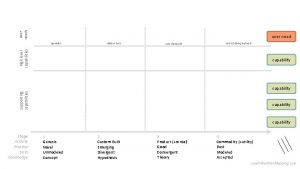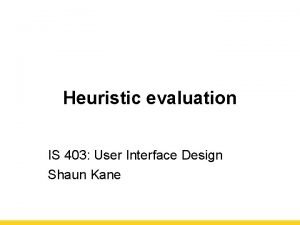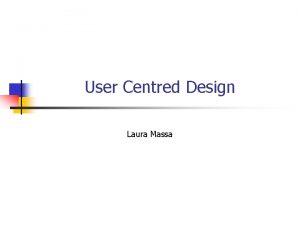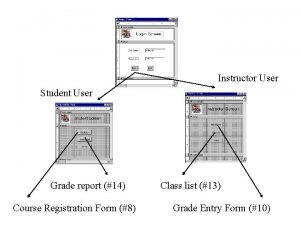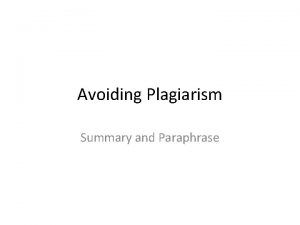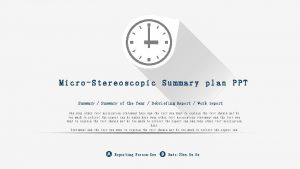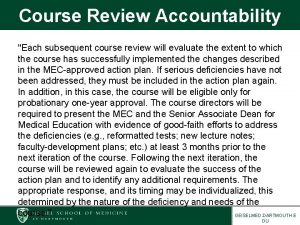Course summary Q 3 review IS 403 User












































- Slides: 44

Course summary, Q 3 review IS 403: User Interface Design Shaun Kane 1

Admin • Assignment 9 extended from Friday until Tuesday (our last class) • Will accept resubmissions until Thursday, December 12 • Q 2 back at end of class 2

Upcoming events • Thursday: – Quiz 3 • Monday 1: 59 pm: – A 10: 3. 5 minute presentation on your project • Tuesday: – Assignment 9 (final design) due – Assignment 10 prez – Participation form (optional, by email) • Wednesday: FREEDOM! 3

Quiz 3 review 4

Quiz 3 preparation • Covers content since the last quiz – Interaction design – Heuristic evaluation – Usability testing – Mobile UIs – Accessibility – Audio and UI metaphors 5

Q 3: Interaction design • Principles of interaction design • Web site layout features (e. g. navigation) • Norman – Gulf of execution, evaluation – Affordances, mapping, system status, feedback 6

Q 3: Heuristic evaluation • Usability heuristics – What are they? – What a heuristic evaluation is 7

Q 3: Usability testing • Guidelines for conducting a think-aloud • What a think-aloud is • Krug on user testing (not covered in class) 8

Q 3: Today’s class • Principles of audio UIs • UI metaphors (basics) 9

Q 3: Mobile UIs • Reading: Cui (what they did, high level findings) • How mobile devices are different • Effects of mobility (at a high level) • Responsive web design: what it is 10

Q 3: Accessibility • What accessibility is • Types of disabilities covered in class (and how to accommodate them) • Assistive technology (screen readers and magnifiers) 11

Q 3: Today’s class • Summary • Using audio in UIs: when and how? • UI metaphors (whatever we get to today) 12

Today • Summary of class topics • Audio UI overview • UI metaphors 13

Summary • What have you learned from this class? • What are the big ideas? 14

Big ideas • Design methods • Design principles 15

Design methods • User-centered design process • Research methods: interviews, affinity diagrams, observation • Ideation: sketching, storyboarding • Prototyping • Testing User research Ideate Prototype Evaluate Done! 16

Design principles • Principles of visual design – Grids, CARP, type rules, color theory • Principles of interaction design – Mapping, feedback, affordance • Accessibility / universal design 17

The secret • These principles can be applied across many domains – Designing audio – Designing physical interfaces – Designing databases – Programming –… 18

Quick example • Designing for audio UIs – What happens when we design for a device with no screen? ! 19

Case study: Roomba 20

Applying design principles to audio feedback 21

Applying design principles to audio feedback • Contrast: major vs. minor key, tempo, volume, • Repetition: finding dead roomba • Mapping: ascending, descending • Feedback: button press boop • Visibility: repeated light, beep • Recognition vs. recall: speech 22

And finally… Metaphors 23

What’s a metaphor? Comparison between two things Mountain of grading 24

Metaphors • Metaphors: Use of concepts and properties which are already familiar to the user • Usually interfaces that tie back to physical artifacts • Why are they useful?

Metaphors • Why are they useful? – Can help “jump start” user’s conceptual models – “Instant knowledge” about how to interact with UI – A way to introduce new technology

Common UI metaphors? • Desktop computer • Mouse -> eats stuff, scares people, makes holes • Inbox • Facebook – “Like” – Poke – Send gifts, post on walls – Friends 27

Metaphor: Magic Cap 1994 • Desktop or hallway metaphor – Information is on paper: letters, files, drawers, roladex etc

“Skeuomorphism” • Using visual identity of a physical object to convey a metaphor 29

Microsoft Bob, 1995 http: //www. telecommander. com/pics/links/application%20 software/microsoft/Microsoft_B ob_1_0/Microsoft_Bob_1_0. htm

Microsoft Bob, 1995

Southwest Airlines

Examples of metaphors we see? • • • Desktop Folders Documents Trash can/Recycle bin Accessories: – Calculator – Clock – Notepad

Shallow Metaphor • Depth of the metaphor has to do with how much of the metaphor you are capitalizing on • Shallow metaphors make use of the one most recognizable aspects of something – Example: Search dog (XP) – Dogs are good at fetching things, so use image of dog under search box – But dogs do other things: • Chew newspapers eat files • Not return object to you share your search with your friends • Other ideas?

Broken/Inappropriate Metaphor • Not informative, may just be confusing – Example: Use a cat (cats don’t fetch on command!) • Why is a paper clip talking to me?

Mixed Metaphor • When two or more different metaphors coexist – May seem related, but not actually – Can be confusing • How do you eject a USB stick or CD in Mac OS X? – Trashcan metaphor: put items you are done with in the trashcan – Empty trash when you are done to delete them forever – What happens when I drag my USB stick to the trashcan?

What about Twitter’s metaphors?

When to use metaphor? • Challenges: – Cute vs. Functional – Shallow, mixed, or broken metaphors make understanding metaphors more difficult – Can prematurely constrain interfaces • But. . . with the right metaphor, learning interfaces can be much easier

Metaphor Guidelines • Do use metaphor sparingly, carefully, and respectfully. • Do take metaphors far enough—but don’t take them too far. • Do make metaphors culturally appropriate. • Do make metaphors brand appropriate. • Do reinforce metaphors with visuals and media. • Do test your metaphors. Full list of Dos and Don’ts: http: //www. uxmatters. com/mt/archives/2008/10/themagic-of-metaphor. php

Good Examples of Metaphor • Bump Top (CHI, 2006) • http: //www. youtube. com/watch? v=M 0 O Dskd. EPn. Q • Fold n’ Drop (UIST, 2004) • http: //www. youtube. com/watch? v=VAW n. IGo 9 Kro

Activity (time permitting) • Pair up with a partner • Find examples of good and bad metaphors on your mobile device • Bonus: find examples of good/bad audio design 41

Upcoming classes • Thursday: quiz : ( • Tuesday: presentations : D 42

Q 2 overview • • • Mean 85. 6 Median 88. 3 Max 106. 7 Min 55. 0 SD 15. 2 • Up slightly from Q 1, but spread is larger 43

44
 Cse 403
Cse 403 Po 403
Po 403 What is considered high voltage
What is considered high voltage Envirobond 403
Envirobond 403 Direct coding in computer graphics
Direct coding in computer graphics Cse 403
Cse 403 403
403 Quantas prendas a turma 403 já levou para a escola
Quantas prendas a turma 403 já levou para a escola Prime factorization 225
Prime factorization 225 403 b 9 church plans
403 b 9 church plans Intervalo p-f
Intervalo p-f Cs 403
Cs 403 Single user and multiple user operating system
Single user and multiple user operating system Single user and multi user operating system
Single user and multi user operating system How to install a lintel in a single brick wall
How to install a lintel in a single brick wall Course number and title
Course number and title Course interne course externe
Course interne course externe Pediatric board review courses
Pediatric board review courses Hbs eoc review
Hbs eoc review Dr henry lindner
Dr henry lindner California regulatory review course
California regulatory review course Allergy board review course
Allergy board review course Comlex level 2 ce prep course
Comlex level 2 ce prep course Stanford hci group
Stanford hci group Chapter review motion part a vocabulary review answer key
Chapter review motion part a vocabulary review answer key Uncontrollable spending ap gov
Uncontrollable spending ap gov Narrative review vs systematic review
Narrative review vs systematic review Search strategy example
Search strategy example Narrative review vs systematic review
Narrative review vs systematic review Introduction for a book review
Introduction for a book review Yahoo user interface
Yahoo user interface What is xul
What is xul Use case and user story
Use case and user story Famweb login
Famweb login Hpc user forum
Hpc user forum Crm user group
Crm user group Multi user weighbridge software
Multi user weighbridge software User-mode driver framework
User-mode driver framework Task analysis adalah
Task analysis adalah User support examples
User support examples Jukebox mc stories
Jukebox mc stories Story card example
Story card example User scenario
User scenario User requirements notation
User requirements notation Graphical user interface testing
Graphical user interface testing
